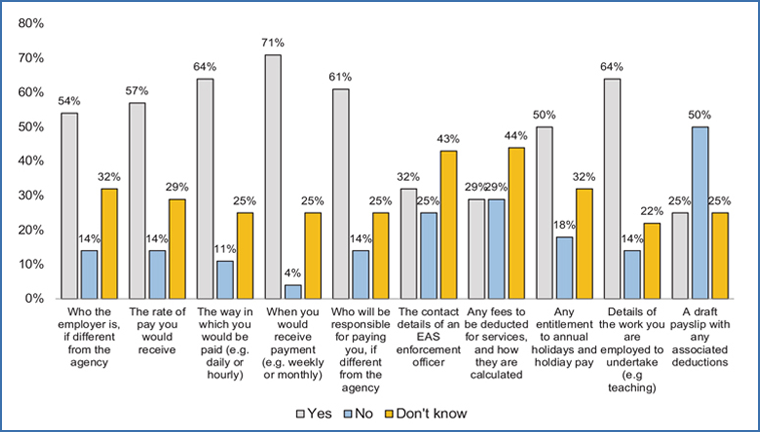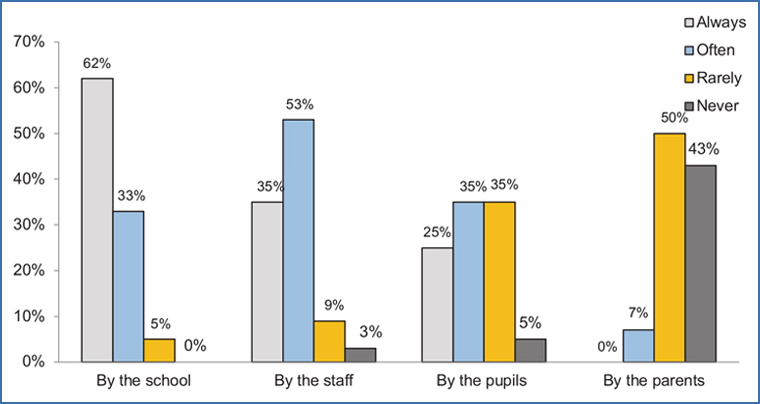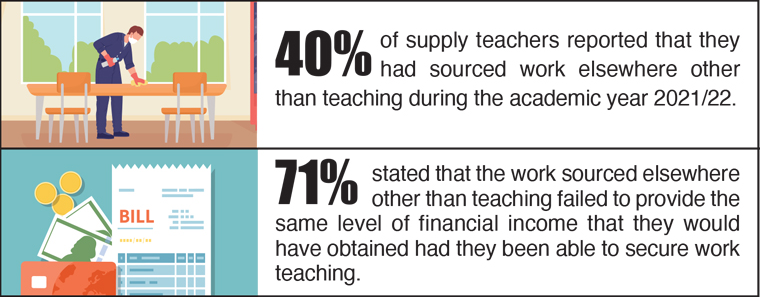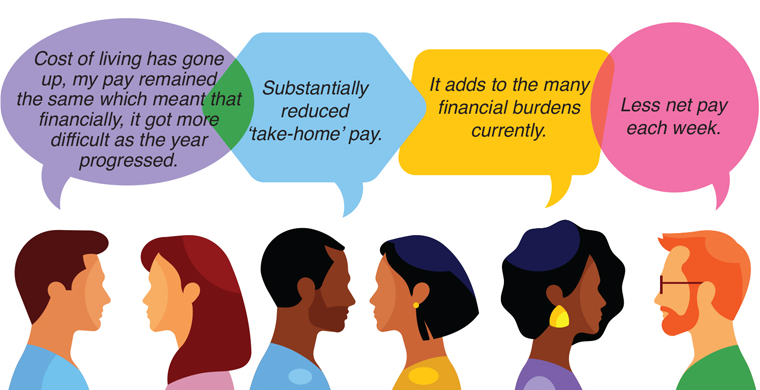Introduction
The survey
Nature of work
Access to work
Availability of work
Working for an agency and/or an umbrella company during the academic year 2021/22
Working for a local authority during the academic year 2021/22
Working directly for a school during the academic year 2020/22
Experiences of supply teachers when undertaking work in schools during the 2021/22 academic year
Health and safety issues for supply teachers during the academic year 2021/22
Rates of pay for supply teachers who were not paid in line with the NPS during the academic year 2021/22
Financial situation during the academic year 2021/22
Training and behaviour management support
Conclusion
Introduction
Supply teachers are integral to the education system, a fact that has been brought into sharp focus as schools have continued to deal with the fallout from the Covid-19 pandemic during 2021/22. Without supply teachers, many pupils would be denied the opportunity to be taught by qualified and dedicated teachers who ensure that schools can continue to provide the education to which children and young people are entitled. Supply teachers make a vital contribution to securing high educational standards for all children and young people.
Despite this, the experiences of many supply teachers suggest that developments such as deregulation have had a detrimental impact upon the deployment of supply teachers and their pay and working conditions, particularly when considered alongside teachers with a contract of employment at a school/college.
The NASUWT’s annual survey of supply teachers in Wales aims to examine the changing experiences of supply teachers, including issues and trends.
The 2022 survey was undertaken between July and August.
A total of 66 supply teachers responded to the survey.
This Report provides the findings from the 2022 survey of supply teachers and highlights the experiences of supply teachers during the academic year 2021/22.
The survey
Nature of work
Supply teachers were asked about their ability to secure work teaching during the academic year 2021/22. Just under nine out of ten (89%) reported that they had no problem securing work, whereas 11% reported that they had problems securing work. Of those who reported problems securing work, 2% stated that they had significant problems securing work.
I worked nearly every day during the last academic year.
The normal shortage at the end of the academic year was not evident this year.
Access to work
During the academic year 2021/22, just over one in ten of supply teachers (12%) reported that they were working for one school, 14% reported that they were working for two schools, 16% reported that they were working for three schools, 14% reported that they were working for four schools, and just under one in ten (9%) reported that they were working for five schools. Well over a third of supply teachers (35%) reported that they were working for more than five schools.
Of those supply teachers who reported that they were able to secure work during the academic year 2021/22, well over nine out of ten supply teachers (94%) said that they had secured work through a supply agency, whilst 17% reported that they had secured work directly as a supply teacher by a school, and just over one in twenty (6%) stated that they had secured work via a local authority supply pool.
Availability of work
Supply teachers were asked where they were able to obtain work during the academic year 2021/22.
Well over two fifths of supply teachers (45%) who responded to the survey stated that their supply work took place in primary schools. Well over two fifths (45%) stated that their work was in secondary schools. One in ten supply teachers (10%) reported that their supply work took place in a special school/pupil referral unit (PRU).

For those supply teachers who reported that they were able to secure work during the academic year 2021/22, well over two fifths (43%) reported that the majority of their supply teaching was ad hoc/daily work, just over one in ten (12%) said that this was weekly assignments, and 3% stated that this was monthly assignments. Just over one in ten of supply teachers (12%) reported that the majority of their work was termly assignments, and 30% stated that the majority of their teaching was on longer term assignments in excess of a term.
When supply teachers were asked how many days on average they were able to obtain work during the academic year 2021/22, just over one in 6% said they obtained work one day a week, just under one in ten (9%) two days a week, and 15% three days a week. Fifteen per cent of supply teachers in the survey said they were able to obtain work for four days a week, and well over half (54%) stated that they were able to obtain work five days a week.
Just 3% of supply teachers stated that the amount of supply work had decreased during the academic year 2021/22, compared to the previous academic year. Over half (52%) stated that the amount of supply work had increased, and well over two fifths (45%) of respondents stated that the opportunities had stayed the same.
Just over a quarter of supply teachers (26%) reported that they had to travel further than in previous years in order to secure work.
None of the supply teachers who had attained work through the Recruit, Recover and Raise Standards (RRRS) were kept on in their role during the 2021/22 academic year.
I was able to work on all the days I was available.
Post-pandemic, I am getting messages for jobs all the time. I keep getting told there is a shortage of qualified supply staff.
Working for an agency and/or an umbrella company during the academic year 2021/22
Supply teachers were asked about their experiences working through an agency and/or umbrella company during the academic year 2021/22.
For those supply teachers working through an agency during the academic year 2021/22, well over half of respondents (54%) stated that they were signed up to one agency to secure work, one fifth (20%) reported that they were signed up to two agencies, 15% reported that they were signed up to three agencies, one in 20 (5%) reported that they had signed up to four agencies, and 2% reported that they were signed up to five agencies. Just under one in 20 (4%) reported that they were signed up with more than five agencies.
A quarter of supply teachers (25%) stated that this was more agencies than they were signed up to during the previous academic year, 12% reported that this was less, and well over three fifths (64%) stated that it had stayed the same. Just under a third of those who responded (32%) stated that this was the direct result of the way in which they were treated by the agency/agencies during the Covid-19 pandemic.



Worked with one agency then joined another which increased supply work.
Previous agency were recommending practices that I felt uncomfortable with during the pandemic.
The agencies and the schools are not great, sometimes cancelling jobs on the way to the school.

Working for a local authority during the academic year 2021/22
Supply teachers were asked about their experiences working through a local authority during the academic year 2021/22.
For those supply teachers working for a local authority during the academic year 2021/22, just under half (48%) reported that they were working for one local authority, over a quarter (28%) stated that they were working for two local authorities, just under one in ten (8%) reported working for three local authorities, and just under one in 20 (4%) reported working for four local authorities. Twelve per cent of supply teachers reported working for more than five local authorities.
Under two fifths of supply teachers (37%) stated that this was more local authorities than they were signed up to during the previous academic year, 4% reported that this was less, and just under three fifths (59%) stated that it had stayed the same. Just under one in 20 of those who responded (4%) stated that this was the direct result of the way in which they were treated by the local authority/authorities during the Covid-19 pandemic.
Working directly for a school during the academic year 2020/21 and the subsequent lockdown from January 2021
Supply teachers were asked about their experiences working directly for a school during the academic year 2021/22.
For those supply teachers working for directly for a school during the academic year 2021/22, over two fifths (42%) stated that they were working directly for one school, just over one fifth (21%) reported working directly for two schools, and one in twenty (5%) were working directly for four schools. Just under a third of respondents (32%) stated that they were working directly for more than five schools.
Twenty-eight per cent of supply teachers stated that this was more schools than they were signed up to during the previous academic year, 5% reported that this was less, and just over two thirds (67%) stated that it had stayed the same. Just over one in 20 of those who responded (6%) stated that this was the direct result of the way in which they were treated by the local authority/authorities during the Covid-19 pandemic.
Experiences of supply teachers when undertaking work in schools during the 2020/21 academic year
Just over three fifths (62%) of supply teachers reported that they are always made to feel welcome by the school, and just a third (33%) stated that they are often made to feel welcome by the school. However, one in 20 (5%) said that they are rarely made to feel welcome by the school.
When asked how welcome they are made to feel by the staff in schools, just over a third of supply teachers (35%) reported that they are always made to feel welcome, and well over half (53%) reported that they are often made to feel welcome by the staff in schools. However, just under one in ten (9%) reported that they are rarely made to feel welcome by the staff in schools, and 3% reported that they are never made to feel welcome by the staff in schools.
When asked how welcome they are made to feel by the pupils in schools, a quarter of supply teachers (25%) reported that they are always made to feel welcome, and just over a third (35%) reported that they are often made to feel welcome by the pupils in schools. However, over a third (35%) reported that they are rarely made to feel welcome by the pupils, and one in 20 (5%) stated that they are never made to feel welcome by the pupils.
In respect of being made to feel welcome by the parents, over one in 20 supply teachers (7%) stated that they are often made to feel welcome. However, half (50%) stated that they they are rarely made to feel welcome by the parents, and over two fifths (43%) stated that they are never made to feel welcome by the parents.

Supply teachers who were able to secure work during the 2021/22 academic year were asked about the provision of key information by the agency and/or the school when undertaking an assignment.
Just over one in ten supply teachers (12%) stated that they were given the school’s overall risk assessment by the agency, compared to over two fifths of supply teachers (43%) who stated that they were given the information by the school. Thirty-seven per cent stated that they were not given the information, and just under one in ten (8%) stated that they were not sure.
Just over one in 20 supply teachers (7%) stated that they were given the procedures and protective measures for staff to follow to reduce the risk of transmission of Covid-19 by the agency. This compares to three fifths of supply teachers (60%) who stated that they were provided with the information by the school. A quarter of supply teachers (25%) stated that they were not provided with the information, and just under one in ten (8%) stated that they were not sure.
Just over one in ten supply teachers (12%) stated that they were given the arrangements in place for supply teachers to report safely to the workplace by the agency, compared to 37% who stated that they were provided with the information by the school. Just under two fifths of supply teachers (39%) stated that they were not provided with the information, and just over one in ten (12%) stated that they were not sure.
One in ten supply teachers (10%) stated that they were given the details of the procedures and arrangements to ensure there was adequate time for supply teachers to be made aware of, and understand, the systems in place in the school, including in respect of Covid-19 by the agency. This compares to 45% of supply teachers who stated that they were provided with the information by the school. Just under a third of supply teachers (31%) stated that they were not provided with the information, and well over one in ten (14%) stated that they were not sure.
Just 13% of supply teachers stated that they were provided with the details of any designated contact(s) for any questions, problems or emergencies (Covid specific or otherwise) by the agency. This compares to half of supply teachers (50%) who stated that they were provided with the information by the school. Twenty-nine per cent of supply teachers stated that they were not provided with the information, and just under one in ten (8%) stated that they were not sure.
Just under one in ten supply teachers (8%) stated that they were provided with the details of the arrangements to maintain social distancing and minimise contact, as well as how pupils are expected to be managed to ensure social distancing by the agency, compared to just over two thirds of supply teachers (67%) who stated that they were provided with the information by the school. A fifth of supply teachers (20%) stated that they were not provided with the information, and one in 20 supply teachers (5%) stated that they were not sure.
Just over a fifth of supply teachers (22%) stated that the agency did provide them with the details of the steps and procedures in place for twice-weekly asymptomatic testing of all staff, including for supply teachers. This compares to over two fifths of supply teachers (41%) who stated that they were made aware of the details by the school. A third of supply teachers (33%) stated that they were not provided with the information, and just under one in 20 (4%) stated they were not sure.
Just 6% of supply teachers stated that they were provided with the details of the contact person for obtaining the relevant NHS Test and Trace notification from the school, should they have needed to apply for the Self-isolation Support Scheme Payment, by the agency. This compares to just over two fifths of supply teachers (41%) who stated that they were provided with the information by the school. Almost half of supply teachers (49%) stated that they were not provided with the information, and 4% stated that they were not sure.
I felt that information on procedures relating to Covid should have been better communicated more strongly to me from my agency before I went to the school.

When asked about the assignments undertaken during the academic year 2021/22, just under half of supply teachers (48%) reported that they had access to a designated contact person all of the time, whereas 23% reported having access to a designated contact person some of the time. Thirteen per cent of supply teachers reported that they did not have access to a designated contact person, and 16% reported that they did not know.
Some schools didn’t even have a map of the building.
Health and safety issues for supply teachers during the academic year 2021/22
Just under half of supply teachers (48%) who secured work during the academic year 2021/22 stated that they were concerned about their health and safety when in schools, and just under one in ten (8%) stated that they may have been penalised or had work cancelled for disclosing personal information about their health and safety.
Often schools will just not rebook a supply teacher who raised health and safety issues.
If you don’t work, you don’t get paid, so you manage the risks.
Almost four fifths of supply teachers (78%) at greater vulnerability to Covid-19 reported that their employer did not complete an individual risk assessment with them before undertaking an assignment.
Rates of pay for supply teachers who were not paid in line with the NPS during the academic year 2021/22
In respect of rates of pay, supply teachers who were able to secure work through an agency/agencies on the National Procurement Service (NPS) were asked if they had been paid in line with at least the equivalent rate of M1 (£141.71 for the academic year 2021/22). Just under nine out of ten supply teachers (89%) reported that they had been paid in line with at least the equivalent rate of M1, whereas 7% of supply teachers (24%) stated that this was not the case.
Daily rate with Excell Supply is £126.45.
For those supply teachers who were not paid in line with the arrangements set by the NPS for the academic year 2021/22, over one in ten (13%) stated that they were paid between £51 and £119 per day for assignments, just under two fifths (38%) stated that they were paid at between £120 and £149 a day, and well over two fifths (44%) stated that they were paid at between £150 and £199 a day for assignments. Over one in 20 (6%) stated that they were paid at less than £50 per day for assignments.

Twenty-five per cent of supply teachers stated that they were ableto secure more money when working through a local authority or directly with a school in comparison to supply work through an agency.
Around £60 a day more (before deductions).
£53.03 per day more working through the County Council.
Just over half of supply teachers (52%) indicated that the rates of pay received during the academic year 2021/22 were the same as those they were able to earn in the previous academic year, whereas just under one in ten (9%) reported that the rates of pay received were less than those they were able to earn in the previous academic year. Just under two fifths (39%) said that the rates of pay received had increased, compared to those they were able to earn in the previous academic year.
When asked if the agency/agencies where they undertook work during the academic year 2021/22 operated a ceiling in respect of their remuneration, just over a fifth of supply teachers (22%) reported that the agency/agencies did.
Of those who responded, three fifths (60%) stated that the ceiling was up to £149 per day and two fifths (40%) stated that the ceiling was up to £199 per day.
Just 13% of supply teachers stated that they were able to secure work through the National Tutoring Programme (NTP) during the academic year 2021/22.
Financial situation during the academic year 2021/22
Supply teachers were asked about their financial situation during the academic year 2021/22.

A fifth of supply teachers (20%) reported having to claim some form of state benefit during the academic year 2021/22 (e.g. Universal Credit), and just under half of respondents (49%) stated that they had experienced financial hardship as a supply teacher over the same period. Of those, just under two fifths (39%) reported that this was a result of the situation in regards to Covid-19.
I had Covid three times and was unable to work, and could only manage part-time work for a few months when recovering.
Forty-nine per cent stated that they had experienced financial hardship as a supply teacher.

Well over half of supply teachers (54%) reported that they were required to self-isolate during the academic year 2021/22. Of those, just under three fifths (58%) reported that their employer did not make them aware of whether they were eligible for Statutory Sick Pay (SSP), and a fifth of supply teachers (20%) reported that they did not know.
Over a third of supply teachers (35%) who were required to self-isolate reported that they were not eligible for any financial support (e.g. Self-isolation Support Scheme), and just under two fifths (39%) reported that they did not know.

Training and behaviour management support
Just under a third (31%) of supply teachers stated that they had not been given access to continuing professional development (CPD) opportunities in the last 12 months.
For those supply teachers who had access to CPD, the primary sources of training were obtained via a supply agency (58%), the schools at which they worked (38%), from their trade union (20%) or funded personally (20%).
We are treated like we are not good enough and that, even with many years’ experience, we are like newly qualified and have no clue of any school-related issues.
Supply teachers in general are looked down upon.

Based on their experiences as a supply teacher during the academic year 2021/22, over two fifths of supply teachers (42%) reported that they were looking for work outside of teaching.
Overall, I have found my role is getting more challenging and difficult to deal with and am looking for roles outside of the education sector.
Conclusion
The 2021/22 survey of supply teachers further reinforces the vital role that supply teachers have played as schools and colleges have continued to emerge from the worst excesses of the Covid-19 pandemic.
However, the survey suggests that the experiences of supply teachers throughout the pandemic and the academic year 2021/22 have been varied. For a proportion of supply teachers, the opportunities for work has increased, including longer work in excess of a term, whereas others have seen their opportunities for work decrease, some to the extent that there has been an increase in those supply teachers having to seek work elsewhere.
The situation for supply teachers has been compounded by the cost-of-living crisis and levels of inflation the likes of which have not been seen for decades. Despite an increase in the level of payment received for daily assignments, for many supply teachers who are subject to the vagaries of intermittent and insecure employment, the cost-of-living crisis is ever more prescient.
The lack of financial support, including for periods of Covid-related self-isolation, coupled with the rise in National Insurance from April 2022, has placed more supply teachers in a precarious financial situation where they have had to make tough decisions about their expenditure, including a significant increase in those supply teachers who are cutting back on their expenditure on food or who have increased their overdraft in order to make ends meet.
Given that the overwhelming majority of supply teachers are female, there are concerns that these disparities in treatment are impacting disproportionately on women, as well as Black and disabled teachers, who are more likely to be employed as supply teachers.
Furthermore, the continued failure of some agencies and schools to address and provide the most basic health and safety information is having a detrimental impact on hard-working and dedicated supply teachers when undertaking an assignment.
In this context, the results from the 2022 Survey substantiate the pressing need for a better deal for teachers which seeks to addresses the concerns of hard-working and dedicated supply teachers.
The full survey report can be downloaded on the right/below.
